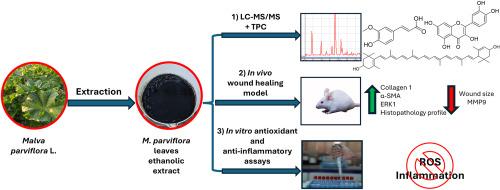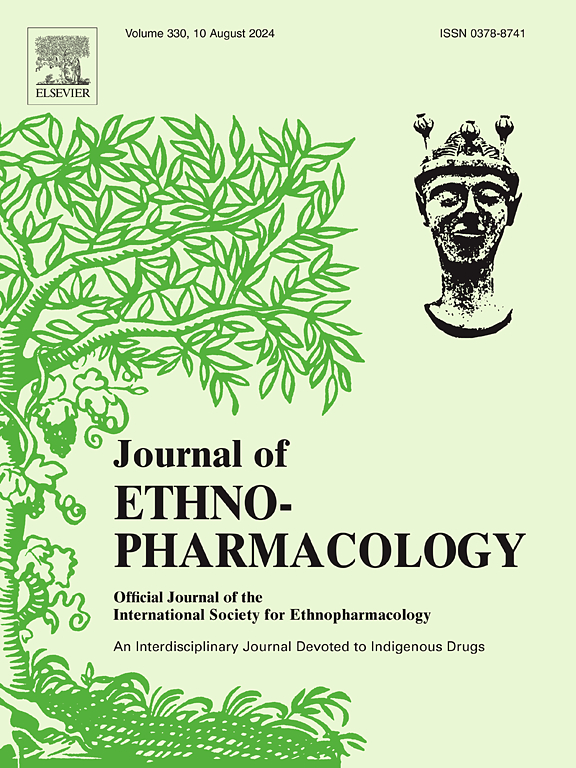锦葵乙醇提取物的植物化学分析和伤口愈合特性
IF 4.8
2区 医学
Q1 CHEMISTRY, MEDICINAL
引用次数: 0
摘要
民族药理学相关性科学出版物记载了我们的祖先使用锦葵属植物治疗炎症和皮肤疾病的情况。材料和方法采用液相色谱电喷雾离子化串联质谱法(LC/ESI-MS/MS)鉴定乙醇提取物中的不同代谢物。此外,还使用 Folin-Ciocalteu 试剂测定了总酚含量。为了验证提取物的伤口愈合潜力,采用了大鼠体内伤口切除模型。用无菌活检穿刺针造成圆形伤口(直径 5 毫米)。用植物提取物(2.5% 和 5%)以及市售伤口愈合产品(Mebo®)处理伤口 10 天。结果评估如下1) 与原始伤口大小相比,测量伤口面积减少的百分比。2) 评估伤口愈合生物标志物的水平,即 I 型胶原蛋白(Col-1)、α 平滑肌肌动蛋白(α-SMA)、细胞外信号调节激酶-1(ERK1)和基质金属蛋白酶-9(MMP9)的水平。3) 对伤口组织进行组织病理学检查。采用多种检测方法研究了茜草叶乙醇提取物的抗氧化特性:总抗氧化能力(TAC)、铁还原力(IRP)、1,1-二苯基-2-苦基肼(DPPH)和 2,2′-偶氮双(3-乙基苯并噻唑啉-6-磺酸)(ABTS)自由基清除检测。结果液相色谱串联质谱(LC-MS/MS)分析表明,M. Parviflora 乙醇中含有多种次生代谢物。乙醇提取物中存在多种次生代谢物,包括酚酸(肉桂酸和阿魏酸)、类黄酮(槲皮素和 "异 "鼠李素单葡糖苷)、脂肪酸(羟基十八碳三烯酸和氧代十八碳三烯酸),此外还有叶绿素衍生物和类胡萝卜素(分别为pheophorbide-a和叶黄素)。与未经处理的对照组相比,麦冬提取物能明显缩小伤口。提取物还通过上调胶原蛋白 I、α-SMA 和 ERK1 的水平,同时下调 MMP9 的表达来促进伤口愈合。值得注意的是,2.5%和5%提取物的效果与Mebo®相似或更高,组织病理学结果也证明了这一点。最后,M. parviflora 乙醇提取物的抗氧化和抗炎潜力与所用标准相当。许多已鉴定的代谢物都具有伤口愈合、抗氧化和/或抗炎活性,这一事实进一步证实了这一点。本文章由计算机程序翻译,如有差异,请以英文原文为准。

Phytochemical analysis and wound healing properties of Malva parviflora L. ethanolic extract
Ethnopharmacological relevance
Scientific publications documented the use of plants from Genus Malva to treat inflammatory diseases and skin disorders by our ancestors. Malva parviflora L. has reported benefits for wound healing in traditional medicine; however, there is a lack of experimental study to validate these claims.
Aim
We initiated this study to explore the metabolites and verify the wound healing properties of M. parviflora using in vivo and in vitro models.
Materials and methods
Liquid chromatography electrospray ionization tandem mass spectrometry (LC/ESI-MS/MS) was used to identify the ethanolic extract different metabolites. Additionally, total phenolic content was determined using Folin-Ciocalteu reagent. To verify the extract wound healing potential, an in vivo rat wound excision model was employed. Round wounds (5 mm in diameter) were created by a sterile biopsy punch needle. The wounds were treated with plant extracts (2.5% and 5%) as well as a commercially available wound healing product (Mebo®) for 10 days. The results were assessed as follows: 1) Measuring the reduction% in wound area compared to the original wound size. 2) Evaluation of the levels of wound healing biomarkers, namely collagen type I (Col-1), alpha smooth muscle actin (α-SMA), extracellular signal-regulated kinases-1 (ERK1), and matrix metalloproteinase-9 (MMP9) levels. 3) Performing histopathological examination of the wound tissue. The antioxidant properties of the M. parviflora leaves ethanolic extract were investigated using various assays: total antioxidant capacity (TAC), iron reducing power (IRP), 1,1-Diphenyl-2-picryl-hydrazyl (DPPH), and 2,2′-azinobis-(3-ethylbenzothiazoline-6-sulfonic acid) (ABTS) radicals scavenging assays. Furthermore, the anti-inflammatory activity was confirmed by calculating the inhibition percentages of protein denaturation and the activity of the proteinase enzyme.
Results
Liquid chromatography tandem mass spectrometry (LC-MS/MS) analysis revealed the presence of various secondary metabolites in M. parviflora ethanolic extract, including phenolic acids (cinnamic and ferulic acids), flavonoids (quercetin and “iso”rhamnetin monoglucuronides), fatty acids (hydroxy-octadecatrienoic and oxo-octadecatrienoic acids), in addition to chlorophyll derivatives and carotenoids (pheophorbide-a and lutein, respectively). Malva extracts significantly reduced wound size compared to untreated control group. The extracts also promoted wound healing by upregulating collagen I, α-SMA, and ERK1 levels, while downregulating MMP9 expression. Notably, the effect of 2.5% and 5% extracts was similar or exceeds those of Mebo®, supported by histopathological results. Finally, M. parviflora ethanolic extract exhibited antioxidant and anti-inflammatory potentials comparable to the used standards.
Conclusion
Our study provides evidence-based support for the wound healing properties of M. parviflora L. leaves ethanolic extract. This is further strengthened by the fact that many of the identified metabolites possess wound healing, antioxidant, and/or anti-inflammatory activities.
求助全文
通过发布文献求助,成功后即可免费获取论文全文。
去求助
来源期刊

Journal of ethnopharmacology
医学-全科医学与补充医学
CiteScore
10.30
自引率
5.60%
发文量
967
审稿时长
77 days
期刊介绍:
The Journal of Ethnopharmacology is dedicated to the exchange of information and understandings about people''s use of plants, fungi, animals, microorganisms and minerals and their biological and pharmacological effects based on the principles established through international conventions. Early people confronted with illness and disease, discovered a wealth of useful therapeutic agents in the plant and animal kingdoms. The empirical knowledge of these medicinal substances and their toxic potential was passed on by oral tradition and sometimes recorded in herbals and other texts on materia medica. Many valuable drugs of today (e.g., atropine, ephedrine, tubocurarine, digoxin, reserpine) came into use through the study of indigenous remedies. Chemists continue to use plant-derived drugs (e.g., morphine, taxol, physostigmine, quinidine, emetine) as prototypes in their attempts to develop more effective and less toxic medicinals.
 求助内容:
求助内容: 应助结果提醒方式:
应助结果提醒方式:


